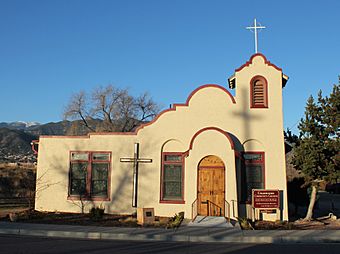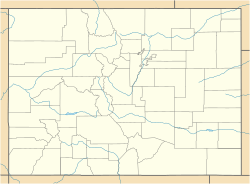Chadbourn Spanish Gospel Mission facts for kids
|
Chadbourn Spanish Gospel Mission
|
|
 |
|
| Location | 402 S. Conejos Street, Colorado Springs, Colorado |
|---|---|
| Built | 1910 |
| Architect | Raymond C. Whitlock |
| Architectural style | Mission Revival |
| NRHP reference No. | 08001316 |
Quick facts for kids Significant dates |
|
| Added to NRHP | January 14, 2009 |
The Chadbourn Spanish Gospel Mission is a special building in Colorado Springs, Colorado. It's designed in a style called Mission Revival. This building is so important that it's listed on the National Register of Historic Places.
Starting in 1928, this mission church offered many services. It provided religious lessons, educational programs, and sports activities. It helped people living in the Conejos District. The Colorado Springs Ministerial Association supported the mission. They created a group to help raise money and find teachers for the church. A nurse named Ruth Chadbourn started the mission. She had been a missionary in Costa Rica and moved to Colorado Springs for her health.
Contents
The Conejos Neighborhood
The Conejos District was a neighborhood in Colorado Springs. It became home to a Mexican community around the early 1900s. These families moved there to work at the nearby Denver & Rio Grande Railroad, mills, and mines. Many came from the San Luis Valley. Before them, people of Scandinavian and Jewish heritage lived in this area.
This neighborhood was located between Colorado Avenue and Mill Street. The Denver & Rio Grande Railroad yard was to the east. Monument Creek was to the west. Families lived in simple houses on small plots of land. There were also local stores to serve the community.
Today, the Chadbourn Spanish Gospel Mission is the only building left from this historic district.
A Church and Community Center
The building was first built in 1910 as a grocery store. It started being used as a mission in 1930. It was then called the Spanish Gospel Mission. Ruth Chadbourn, a missionary, founded it. She wanted to help the community, which faced tough living conditions. Chadbourn rented the building in 1930 and bought it in 1934.
Members of Protestant churches in Colorado Springs formed a group to help manage the mission's money. They also helped raise funds. Ruth Chadbourn passed away in 1936. After that, the mission was named in her honor.
Building Improvements and New Style
The mission building was updated between 1939 and 1940. It was changed to the Spanish Mission style. A bell tower was added, donated by Colorado College. Curved walls called parapets were also added. The building was covered in stucco, a type of plaster. The First United Methodist Church gave beautiful stained glass panels.
The building's style shows its Mission Revival design. You can see this in its square bell tower, curved parapets, and stucco finish. It also has overhanging eaves and arches.
Helping the Community
The church held services in both Spanish and English. It offered Bible and Sunday School classes. Boy Scouts and Girl Scouts met there. Children could join the church's basketball and baseball teams. Adults could take classes in music, sewing, and English. The mission also gave food and Christmas gifts to children in the neighborhood. It was a place for many community events.
The church was a very important center for the Conejos district for a long time. The pastors often spoke up for the Hispanic community in Colorado Springs. For example, in 1942, Pastor Jose Guzman spoke out against unfair treatment. Many Hispanic workers came to Colorado Springs to build Camp Carson. But they saw "No Mexicans Allowed" signs in many businesses. Pastor Guzman asked, "How come we are their equals in the war front, and cannot be their equals in the lunch counter or the beer joint?"
After World War II, the church kept helping families in the Conejos neighborhood. In 1951, Pastor Harry Corney said, "The South Conejos Street district is a black mark against the Colorado Springs community. The people of this city should see how their neighbors on South Conejos Street are forced to live."
The Gazette newspaper wrote about the mission. They said the neighborhood really needed this kind of help. They noted that many children lived in small houses with no playgrounds. The article said that helping kids build good character is much better than dealing with youth problems later. It also showed how different groups and races could work together.
In 1954, the houses and buildings in the district were torn down. The land was then used for businesses and factories. In 2005, America the Beautiful Park was finished across the street from the church. The mission building is still there and holds weekly church services. It is no longer funded by other churches. Its members now include the grandchildren and children of earlier church members.
In 2008, The Gazette reported that the church was slowly growing. They had plans to make the building bigger. The church was able to get grants for construction because of a change in its zoning. Being listed on the National Register of Historic Places helps protect the church's history.
Walking Tour Stop
The Chadbourn Spanish Gospel Mission is a stop on the Southwest Downtown walking tour in Colorado Springs.
See also



